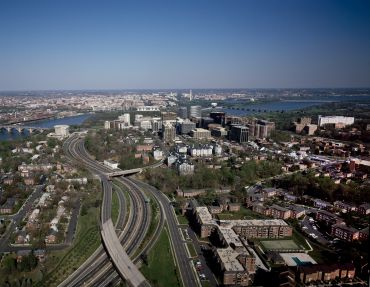America’s infrastructure is crumbling around us. And the warning signs flash all the way from India to here. Because of that country’s size and population, moving commerce and travelers around the subcontinent poses major challenges. Unfortunately, India’s 40,000-mile rail network is over 150 years old. Intercity rail traffic often exceeds 120 percent of capacity, moving at a glacial pace to preserve tracks wearing out faster than designed.
In America, we are fast approaching a similar crisis that is little understood by the public or most governmental officials. Bridges average 50 years in age, their typical intended life span. Metropolitan area drivers spent 4.2 billion hours-nearly a full week per motorist-delayed in traffic in 2007. Congestion costs our nation an unbelievable $78 billion annually!
Yet we will soon spend billions of stimulus dollars on infrastructure repair without knowing how best to improve a failing system. Remediation will cost more than $2.2 trillion, money that is unbudgeted amid today’s financial plight.
To address these problems, we must build and rebuild on a massive scale. But America is burdened with an inefficient construction industry that is just as broken as the infrastructure itself. Forty-eight billion dollars in stimulus money went toward construction of roads and bridges, notwithstanding an industry whose inefficiencies totaled $120 billion in 2007.
By overhauling the way the construction industry operates, before spending billions more on infrastructure, we can make improvements that benefit Americans for generations to come.
Some solutions include:
– Enact reforms to avoid another Big Dig. Boston’s Big Dig is history’s most expensive highway project. Its original 1985 budget was just over $2 billion. The real cost will reach $22 billion.
The Big Dig epitomizes everything wrong with America’s broken construction industry. We cannot afford overruns of 20 percent, 30 percent or more. We cannot afford the waste triggered by contractor inefficiency.
Construction is America’s least productive industry. The average project wastes up to 50 percent of its total labor cost. Taxpayers cannot squander a hundred billion on poor job performance. Yet fixed-priced contracts would save billions.
Construction contracts should (1) be based on 100 percent complete architectural and engineering drawings; (2) include fixed prices for everything designed and approved by the jurisdiction; and (3) fairly apportion anticipated construction-related risks among all parties.
– Create a national clearinghouse and database, accessible to state transportation agencies and the public. The database would identify all infrastructure-related design and construction issues. A similar, federal database would alert state transportation departments of any bridge failure nationwide, and include methodologies for remediation, such as issuing maintenance alerts for America’s 600,000 bridges.
With broad public access to this information, state transportation engineers could take preventive action sooner, reduce traffic on unsafe bridges and boost official accountability. Evidence shows that publicizing infrastructure problems can trigger protective action.
– Expand efforts to inform and protect citizens. One in four bridges is either “structurally deficient” or “functionally obsolete.” States must inform citizens about structural deficiencies-and develop remedial strategies within six months after a bridge is deemed “structurally deficient.” The public should receive annual remediation progress reports and be alerted if repair funds are not provided within 18 months.
– Address the shortage of civil and structural engineers. These professionals are trained in advanced inspection and remediation methodologies. But the lack of state engineering specialists-positions downsized by budget cuts-prevents adequate safety assessments.
State transportation departments must increase compensation to hire and retain engineers to stem their exodus to private industry. Reducing long-term maintenance costs rests with these engineers’ valued experience.
-Invest in technologies that improve accuracy. By the time cracks appear, bridge remediation costs have skyrocketed. Even visual inspections are not totally reliable in detecting cracks.
Technology exists to anticipate bridge remediation years before rust, corrosion and cracks appear. States can save millions by purchasing this equipment and training inspectors to use it.
The financial crisis has forced us to scrutinize our priorities. Thankfully, the Obama administration has made infrastructure repair a priority, understanding that a safe infrastructure is key to our prosperity.
Considering the scale of work required, our scarce infrastructure funds must be used wisely. But if we allow the construction industry to keep conducting “business as usual,” we will end up needlessly wasting billions of taxpayer dollars.
Let India’s precarious and deteriorating infrastructure serve as a warning for the United States. By taking the strategic steps outlined above, America can intelligently rescue our roads, rails and bridges-before it is too late.
Barry B. LePatner, founding principal of LePatner & Associates LLP, is a corporate construction counsel to owners and the author of Broken Buildings, Busted Budgets: How to Fix America’s Trillion Dollar Construction Industry (University of Chicago Press, 2007). His new book, Too Big to Fall: America’s Failing Infrastructure and the Way Forward, will be published this fall by the University Press of New England.


